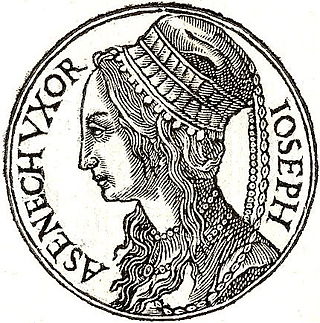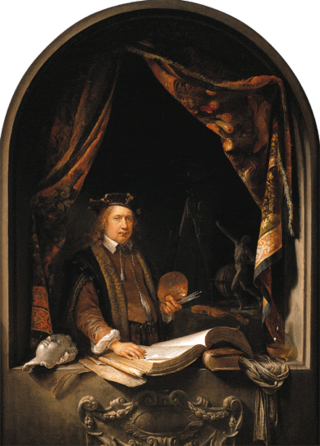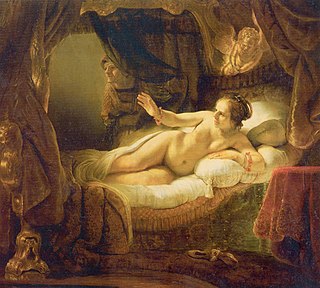Potiphar is a figure in the Hebrew Bible and the Quran. His name possibly indicates the same figure as Potiphera.

Joseph is an important Hebrew figure in the Bible's Book of Genesis. He was the first of the two sons of Jacob and Rachel. He is the founder of the Tribe of Joseph among the Israelites. His story functions as an explanation for Israel's residence in Egypt. He is the favourite son of the patriarch Jacob, and his envious brothers sell him into slavery in Biblical Egypt, where he eventually ends up incarcerated. After correctly interpreting the dreams of Pharaoh, however, he rises to second-in-command in Egypt and saves Egypt during a famine. Jacob's family travels to Egypt to escape the famine, and it is through him that they are given leave to settle in the Land of Goshen.

Saskia van Uylenburgh was the wife of painter Rembrandt van Rijn. In the course of her life, she was his model for some of his paintings, drawings, and etchings. She was the daughter of Rombertus Uylenburg, the mayor as well as the justice of the Court of Friesland.

Asenath is a minor figure in the Book of Genesis. Asenath was a high-born, aristocratic Egyptian woman. She was the wife of Joseph and the mother of his sons, Manasseh and Ephraim.

Gerrit Dou, also known as GerardDouw or Dow, was a Dutch Golden Age painter, whose small, highly polished paintings are typical of the Leiden fijnschilders. He specialised in genre scenes and is noted for his trompe-l'œil "niche" paintings and candlelit night-scenes with strong chiaroscuro. He was a student of Rembrandt.

Vayeshev, Vayeishev, or Vayesheb is the ninth weekly Torah portion in the annual Jewish cycle of Torah reading. The parashah constitutes Genesis 37:1–40:23. The parashah tells the stories of how Jacob's other sons sold Joseph into captivity in Egypt, how Judah wronged his daughter-in-law Tamar who then tricked him into fulfilling his oath, and how Joseph served Potiphar and was imprisoned when falsely accused of assaulting Potiphar's wife.

Rembrandt Harmenszoon van Rijn, usually simply known as Rembrandt, was a Dutch Golden Age painter, printmaker, and draughtsman. He is generally considered one of the greatest visual artists in the history of Western art. It is estimated Rembrandt produced a total of about three hundred paintings, three hundred etchings, and two thousand drawings.

Danaë is a painting by the Dutch artist Rembrandt van Rijn. It was first completed in 1636, but Rembrandt reworked it significantly by 1643 at the latest. Once part of Pierre Crozat's collection, it has been in the Hermitage Museum, in St. Petersburg, Russia since the 18th century.

Potiphar's wife is a figure in the Hebrew Bible and the Quran. She was the wife of Potiphar, the captain of Pharaoh's guard in the time of Jacob and his twelve sons. According to the Book of Genesis, she falsely accused Joseph of attempted rape after he rejected her sexual advances, resulting in his imprisonment.

Hendrickje Stoffels was the longtime partner of Rembrandt. The couple were unable to marry because of the financial settlement linked to the will of Rembrandt's deceased wife Saskia, but they remained together until Hendrickje's death. In 1654 she gave birth to Rembrandt's daughter Cornelia. In the later years of their relationship Hendrickje managed Rembrandt's business affairs together with the painter's son Titus.

The Conspiracy of Claudius Civilis is an oil painting by the Dutch painter Rembrandt, c. 1661–62, which was originally the largest he ever painted, at about five by five metres in the shape of a lunette. The painting was commissioned by the Amsterdam city council for the Town Hall. After the work had been in place briefly, it was returned to Rembrandt, who may have never been paid. Rembrandt drastically cut down the painting to a quarter of the original size to be sold. It is the last secular history painting he finished.

Bathsheba at Her Bath is an oil painting by the Dutch artist Rembrandt (1606–1669), finished in 1654.

The Venetian painter Titian and his workshop made at least six versions of the same composition showing Danaë, painted between about 1544 and the 1560s. The scene is based on the mythological princess Danaë, as – very briefly – recounted by the Roman poet Ovid, and at greater length by Boccaccio. She was isolated in a bronze tower following a prophecy that her firstborn would eventually kill her father. Although aware of the consequences, Danaë was seduced and became pregnant by Zeus, who, inflamed by lust, descended from Mount Olympus to seduce her in the form of a shower of gold.

The Hundred Guilder Print is an etching with drypoint by Rembrandt, measuring 278 x 388 mm (platemark). The etching's popular name derives from the large sum of money supposedly charged for it. It is also called Christ healing the sick, Christ with the Sick around Him, Receiving Little Children, or Christ preaching, since the print depicts multiple events from Matthew 19 in the New Testament, including Christ healing the sick, debating with scholars and calling on children to come to him. The rich young man mentioned in the chapter is leaving through the gateway on the right.

The dozens of self-portraits by Rembrandt were an important part of his oeuvre. Rembrandt created approaching one hundred self-portraits including over forty paintings, thirty-one etchings and about seven drawings; some remain uncertain as to the identity of either the subject or the artist, or the definition of a portrait.

Joseph and Potiphar's Wife is a 1640–1645 oil on canvas painting by the Spanish artist Murillo, now in the Gemäldegalerie Alte Meister (Kassel). His later 1660s version of the subject is now in a private collection.

David and Jonathan is a painting by the Dutch painter Rembrandt, made in 1642, now in the collection of the Hermitage Museum in Saint Petersburg, Russia. Painted on oak, it is one of the works, together with the Hellenistic sculpture acquired in 1850, The Venus de Taurida, with which the Hermitage began their collection in 1882.
Joseph and Potiphar's Wife may refer to a number of works based on the story told in Book of Genesis chapter 39:

Joseph and Potiphar's Wife is the only securely attributed work in marble completed by Properzia de' Rossi, the only woman artist in the Italian Renaissance mentioned in the first edition of Giorgio Vasari's Lives of the Most Excellent Painters, Sculptors, and Architects. Despite her inclusion, there is not much information documenting the artist's progression of skill, or who she trained under, leading up to the creation of Joseph and Potiphar's wife. Instead, the artist faced much social backlash surrounding the scandalous imagery and Vasari's own account of the artist's personal connection to the artwork.


















